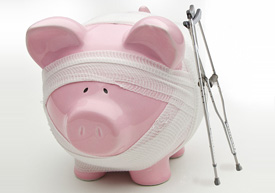Send this article to a friend:
February
01
2014

Send this article to a friend: February |
 |
Summing up Ben Bernanke's reign in four numbers 
First of all, a very Happy New Year to our many Chinese readers. According to the ancient Zodiac, today we are shedding the coils of the year of the Snake in favor of the Horse. Given this symbology, it is perhaps a very small irony that today is also the final day in office for Ben Bernanke, chairman of the US Federal Reserve. Let’s review the statistics:
As of Wednesday, Mr. Bernanke’s Fed now counts $4.1 trillion in assets. And the balance sheet is stuffed full of mortgage debt ‘guaranteed’ by insolvent government agencies.
This capital ratio is a hugely important number in banking that represents a sort of ‘margin of safety’. In a severe crisis situation, banks with a higher capital ratio are able to withstand major financial shocks. Candidly, 3.22% is not high; this means that the Fed would effectively be rendered insolvent if its assets lost more than 3.22% of their value. So the Fed that Mr. Bernanke inherited was not exceptionally healthy. But today, Mr. Bernanke leaves office with the balance sheet in far worse condition. The Fed’s capital ratio is just 1.34%. And it’s deteriorating rapidly. Three years ago, the Fed’s capital ratio was 2.17%. A year ago it was 1.82%. Six months ago it was 1.54%. And now today just 1.34%. It doesn’t take a rocket scientist (or a PhD in economics) to see how quickly this is unraveling. The Fed now has a razor thin margin of safety to guarantee a bloated balance sheet crammed full of questionable assets. This is not exactly the height of responsible stewardship. Has it helped? I suppose that depends on whom you ask.
Today the Dow is at 15,569, and the 10-year note is 2.65%. So this has been a pretty good run for folks who have thrown money in the stock market or have heavily indebted themselves. Yet over 50% of Americans don’t own a single share of stocks. And as of 2010, 10% of Americans own 81% of all stocks. Then there’s the Federal government, which has been able to pass off trillions of dollars of debt to a willing central banker, as well as generate tax revenue from all the stock investors’ capital gains.
It’s fairly clear if you look at the data objectively that Mr. Bernanke’s policies have left the Fed (and consequently the global financial system) in far more precarious condition than when he started, yet disproportionately benefited the US government and small percentage of society at the expense of everyone else. This is not to say that Mr. Bernanke is some evil mastermind bent on nefarious ends. When I listened to him explain his decision-making process at a dinner in Washington a few months ago, it became clear that he is very well intentioned and honestly believes that his policies help. Unfortunately the road to ruin is almost always paved with good intentions. |
|---|
Send this article to a friend:
 |
 |
 |